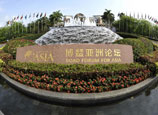
Asian economies have shown a greater interdependency, according to a report released on Tuesday.
The report, conducted by the University of International Business and Economics, and funded by Boao Forum for Asia, showed that in 2011 trade interdependency in Asia was 54.1 percent.
This means that Asian economies' trade with their partners on average accounted for 54.1 percent of their non-Asian trade volume. The percentage was an increase from 53.1 in 2007, when the research was first conducted, but lower than 2010's 54.9 percent.
Lin Guijun, an UIBE international business professor and a coordinator of the report, said though intra-Asia trade is still much lower than that of Europe, it is higher than in North America.
UIBE's study coincided with another Asian integration report conducted by the Asian Development Bank. ADB's index, which monitors foreign direct investment, capital markets, output correlations, trade and tourism across Asia, showed the level of integration rising from a base level of 100 in 2001 to a peak of 233.27 in 2010.
Preliminary data for 2011 showed the level of integration tapering off slightly to 192.22, but still much higher than in 2007.
In general, the two reports depicted a picture mixed with progress and challenges.
On the positive side, each sub-region in Asia has integrated further into the Asian economies.
South Asia, once a poorer region and relatively isolated from economic activities of other Asian nations, has seen trade interdependency steadily rise.
In 2004, its trade with other Asian nations only accounted for 40.25 percent of its non-Asia trade. By 2011, the percentage had risen to 51.71 percent.
India, Thailand, Sri Lanka, Japan, Malaysia and South Korea all saw a significant higher dependency on Asian trade. Malaysia, Thailand, the Philippines, and Indonesia's dependency surpassed 65 percent in 2011.
Compared with other economies, the Chinese mainland has less dependency on its Asian neighbors. For example, though 9.3 percent of India's foreign trade is conducted with China, China's trade with India only accounted for 2 percent of its total trade.
The imbalance also applies to Sino-Japanese trade. China's trade dependency on Japan was estimated at 9.4 percent, while Japan's dependency on China reached 19.8 percent.
"This means that the toll from the escalating row between the two countries has a bigger effect on Japan than on China," said Wang Jun, a researcher at the China Center for International Economic Exchanges.
"But a worsening bilateral relation would undermine both economies, and possibly the East Asian economy as a whole."
The report said regional trade and investment agreements, including the negotiating China-South Korea-Japan free trade agreement and regional comprehensive economic partnership, could lift Asian economies' integration to a new height.
"In the past 10 years, China, South Korea and Japan's trade with one another has steadily stood at 24 percent of their total foreign trade, much lower than North America Free Trade Agreement's 60 percent," Lin said. "So an FTA among the three countries could strengthen their economic cooperation and improve synergy."
Lei Lei Song, principal economist in ADB's Office of Regional Economic Integration, said, "Going forward, greater integration will be harder won as the remaining areas of cooperation are more complex."
















 Snails that are as fat as geese
Snails that are as fat as geese


![]()
